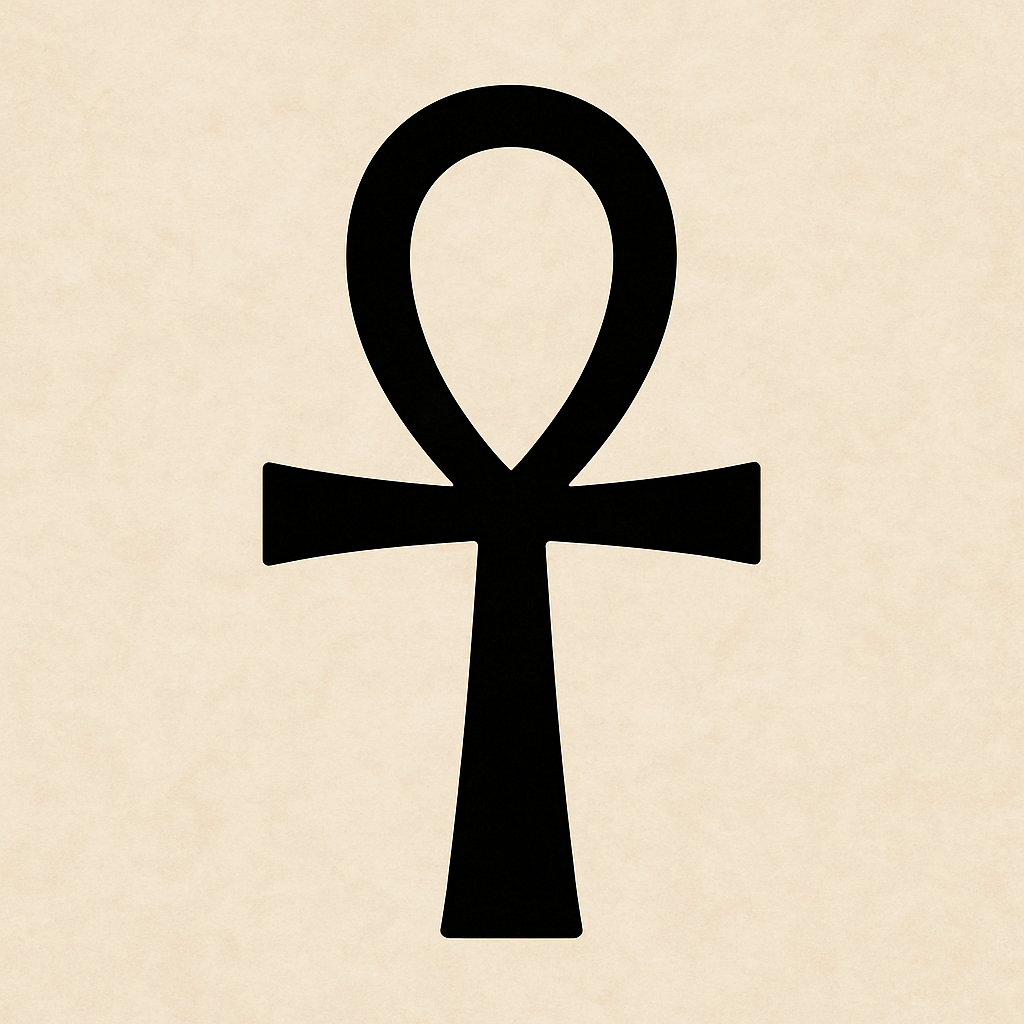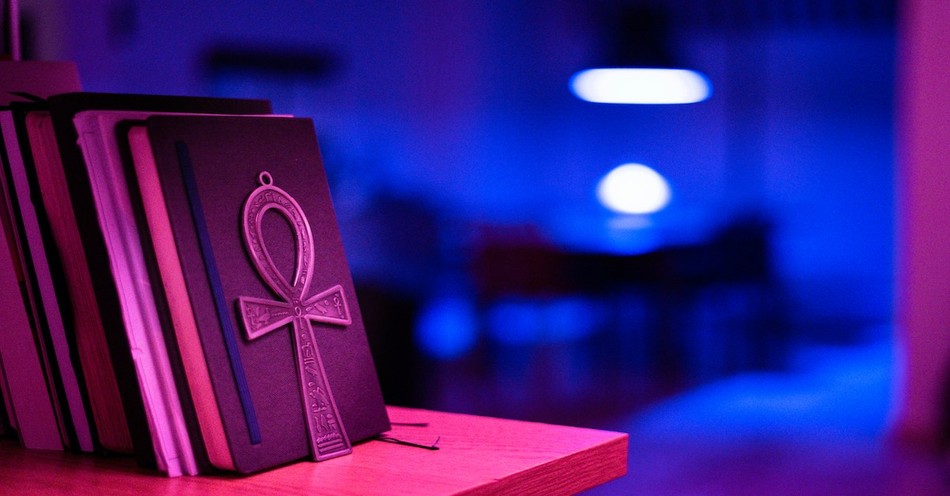The ankh symbol is one of many symbols whose original meaning has been lost to modern cultures. Is it merely stylish jewelry or artwork? Is it acceptable for Christians to wear it? To answer these questions, let’s look at the origins of the symbol and various beliefs about what it symbolizes.
What Is the Ankh and Where Did it Originate?
The Ankh, a cruciform symbol, most likely originated in ancient Egypt. It is a cross with a loop for its upper vertical arm. It is a hieroglyph that means life or living.
Its shape is tied to solar and celestial imagery, with the loop representing the sun and the bar below representing the horizon. Together, the loop and the bar symbolize the cycle of the sun’s daily movement from rising to setting.
The Ankh is also referred to as the “Key of the Nile” with the loop representing the Nile Delta, the bar the intersecting waterways, and the bottom the Nile itself. The water feeds the delta, which sustains life for the area.
What Did the Ankh Symbolize in Ancient Egypt?
The Ankh is associated with Osiris (Egyptian god of resurrection, fertility, and cyclical renewal) and Isis (goddess of magic, protection, and maternal nurturing). According to ancient Egyptian myth, the union of Osiris and Isis symbolizes the harmonizing of opposites, such as life and death or order and chaos, into a balanced whole. The ankh is often seen in artwork as Isis giving the key-like ankh to pharaohs, granting them access to the afterlife.

There are many theories regarding the origin and purposes of the ankh, but no single theory has been proven or unanimously accepted by historians and archaeologists. All the theories relate in some way to the idea of life, such as the cycles of the sun, the cycles of the crops, and even the cycles of human life.
Is the Ankh Connected to Christianity?
Because of its cruciform shape, many believe the ankh is a cross and that it is connected to Christianity. However, the only reference I found of any such connection was to Egypt’s Coptic Christians in the 4th century AD who regarded it as a symbol of Christ’s promise of eternal life through his death and resurrection.
Of course, today, the cross without the loop is considered representative of Christ’s death and resurrection and is an important symbol for Christians. Since the modern cross is a more accurate depiction of the one used in crucifixion, it is more generally used as a symbol of Christianity.
Can Christians Wear or Display the Ankh?
Like any symbol, whether or not wearing or displaying the Ankh is okay for Christians is tied to the meaning you attach to the symbol. According to Merriam-Webster's dictionary, a symbol is “something that stands for or suggests something else by reason of relationship, association, convention, or accidental resemblance, especially a visible sign of something invisible.” For example, a lion is a symbol of courage, and an eagle is a symbol of freedom. The symbol helps us grasp complex ideas, or they help us remember important concepts. The cross is used as a reminder of what Christ has done through his death and resurrection. It holds no power on its own except to point us toward Christ.
Sometimes there is a fine line between a symbol and idolatry. We wear something as a reminder, but as time passes, we forget what it represents. It becomes a comfort to us, a talisman of sorts. Maybe we even become afraid not to wear it, thinking of it as a good luck charm. The symbol becomes more important than what it represents, which is a form of idolatry since we are putting our faith in the symbol instead of the One the symbol represents.
I remember a scene from the movie “The Mummy” (1999) in which a character comes face to face with the creature and starts pulling out talismans that are wrapped around his neck. They came from every religion around the world, but none of them protected him from danger. The only thing that saved him was his ability to speak Hebrew. They were worthless symbols when it came down to facing the enemy.
Scripture has a lot to say about idolatry, which is putting anything above God. When God gave Moses the Ten Commandments in Exodus, the first commandment began with the reminder that there is only one God, and we should worship only him. Here are a few other references to idolatry, especially things made by man:
- Exodus 20:3 – “You shall have no other gods before Me.” (All verses are NKJV.)
- Psalm 135:15-18 – “The idols of the nations are silver and gold, The work of men's hands. They have mouths, but they do not speak; Eyes they have, but they do not see; They have ears, but they do not hear; Nor is there any breath in their mouths. Those who make them are like them; So is everyone who trusts in them.”
- Galatians 4:8 – “But then, indeed, when you did not know God, you served those which by nature are not gods.”
- Isaiah 45:20 - "Assemble yourselves and come; Draw near together, you who have escaped from the nations. They have no knowledge, who carry the wood of their carved image, and pray to a god that cannot save.”
- Jonah 2:8 - "Those who regard worthless idols Forsake their own Mercy.”
Anything made by human hands is merely art. It has no power to save or protect us. Only God, the one true God, has the power to save.
So, in light of all of this, is it okay for Christians to wear or display the Ankh? Well, that depends. Why do you want to wear it or display it? Is it merely artistic, or is it something more?
For example, I have a small, alabaster statue of Bastet in cat form on a shelf in my living room. A friend bought it for me as a souvenir of her trip to Egypt because she knows I like cats. I know Bastet is a myth, and I don’t worship the little statue. I merely enjoy the beauty of the artwork and its connection to my friend.
Many people choose to wear the Ankh in jewelry or clothing because it is a popular fashion statement. Others see it as another form of the cross and connect with it on a spiritual level as a reminder of Christ. So, if you want to wear or use the ankh, the important question is: what is your reason for wanting to do so?
Conclusion
In the end, it comes down to why you want to wear or display it. A symbol only has the meaning that you give to it. So, here are a few things to consider:
- Do you like it because of the aesthetic, the beauty of a piece of jewelry, or are you trying to follow a trend?
- Will wearing the Ankh be a stumbling block for newer Christians in your circle of friends and acquaintances?
- Does it point you to Christ? Can you use it as a conversation starter to point someone to Christ?
- Do you have any uneasiness in your spirit about wearing it?
Part of the reason we have the Holy Spirit is for him to convict us of sin and warn us when we are dabbling in things that might be dangerous for our spiritual well-being. If you want to know whether something is acceptable to God, then research it in the Bible and pray for guidance. The Holy Spirit will never lead you down the wrong path. It may be okay for one person to wear an ankh, but it may be unhealthy for another person because of their personal history or convictions.
The ankh has had varied uses and meanings in the past, from Egyptian idols to the cross of Christ. It is up to the individual believer to decide how God is leading them. If you have any doubt, then it’s probably best to leave it alone. After all, it’s just a symbol.
Photo credit: Unsplash/Ümit Yıldırım
Linda Lyle is a writer, teacher, knitter, and unintentional collector of cats. She has written articles for the Alabama Baptist, Open Windows, Refresh, as well as multiple novels and novellas. Her newest book, 5-Minute Prayer Plan for When Life Is Overwhelming, is set to release in October. She spins yarns on her blog The End of My Yarn at lindalyle.com.




